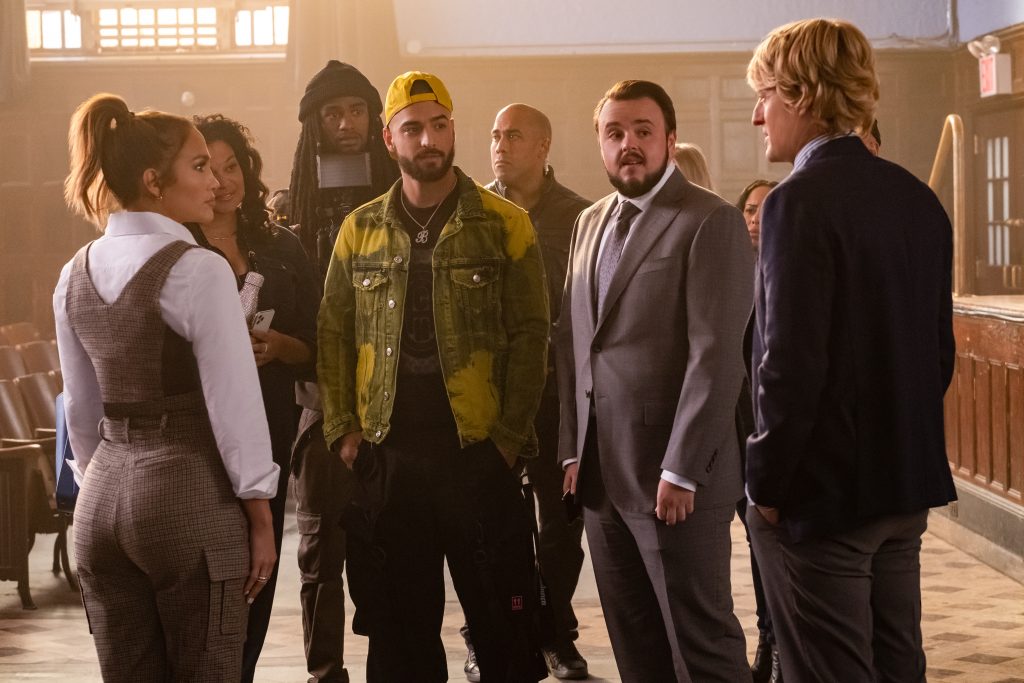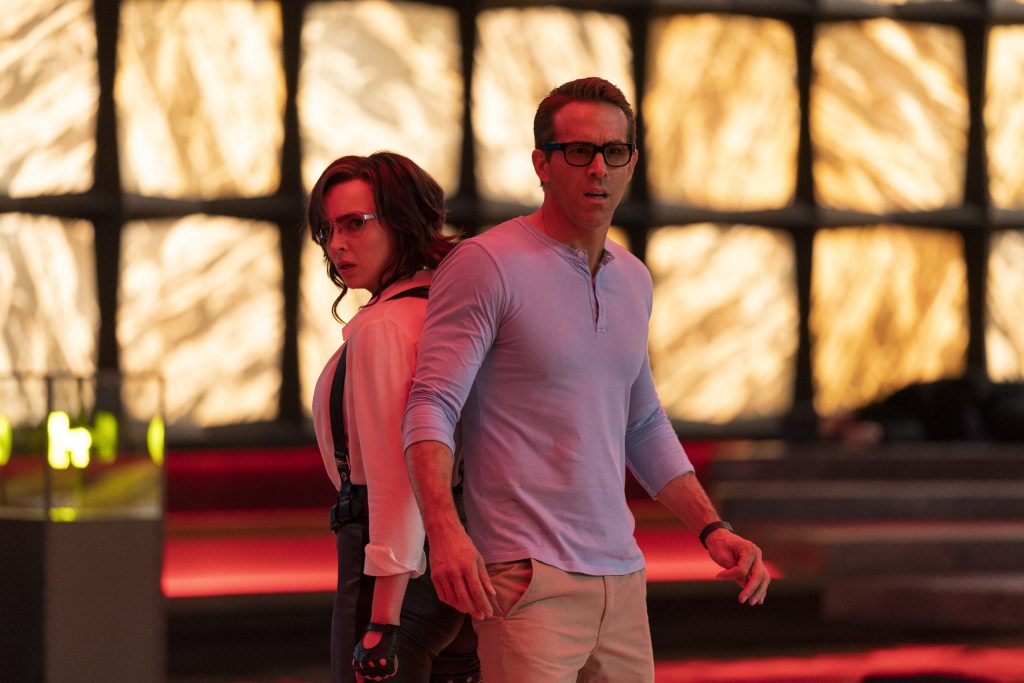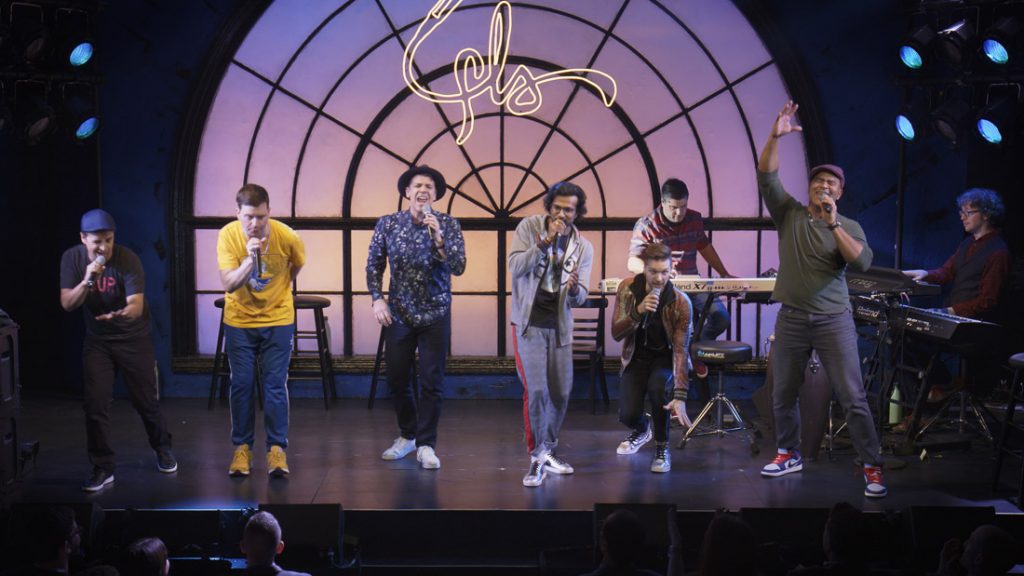February 11, 2022
by Carla Hay

Directed by Kat Coiro
Some language in Spanish with no subtitles
Culture Representation: Taking place primarily in New York City and briefly in Peoria, Illinois, the romantic comedy film “Marry Me” features a racially diverse cast of characters (white, Latino, African American and Asian) representing the working-class, middle-class and wealthy.

“Marry Me” is just an extended music video for Jennifer Lopez to sing songs that she wants to sell in a hackneyed story with no surprises. She and a bland Owen Wilson have no believable chemistry together, even though they star in the movie as an unlikely couple who are supposed to fall in love with each other. The entire movie looks as fake as the myriad of wigs and hair extensions that a superstar diva would wear.
Directed by Kat Coiro, “Marry Me” starts out with a somewhat intriguing concept that asks these questions: What if two famous singers were supposed to get married on a concert stage with a televised audience of millions, but the bride-to-be-finds out minutes before the wedding that her groom-to-be cheated on her? And what if she impulsively decided to marry a “regular guy” stranger in the audience instead? And what if this diva and this “regular guy” actually tried to make their marriage work?
That’s the entire story in “Marry Me,” but the movie does absolutely nothing original with this idea, which might have worked well with a genuinely hilarious screenplay and the right people cast in the roles. Unfortunately, “Marry Me” (written by Harper Dill, John Rogers and Tami Sagher) takes the lazy and unimaginative route, by cramming in cliché after cliché seen in many other romantic comedies until the movie comes to a very underwhelming and formulaic end. The screenplay is based on author Bobby Crosby’s 2020 graphic novel “Marry Me.” The movie “Marry Me” tries too hard to be sweet and likable, but it all comes across as cloying and pandering, especially when this movie is actually designed to peddle Lopez’s music and anything else that got product-placement deals for this movie.
In “Marry Me,” Kat Valdez (played by Lopez) is the heartbroken diva who rebounds quicker than you can say “rom-com garbage.” On the night of her lavish wedding, which takes place at Hammerstein Ballroom in New York City, she finds out just a few minutes before the ceremony that her heartthrob singer fiancé Bastian (played Maluma) cheated on her with her assistant Tyra (played by Katrina Cunningham). A tabloid website has posted a video of Bastian and Tyra having a sexual tryst, and the video has instantly gone viral. Kat and Bastian have a duet called “Marry Me” that they were going to sing to each other during the wedding, which is expected to have a global audience of about 20 million people. As soon as Kat finds out about Bastian’s infidelity, she breaks up with him backstage.
Instead of canceling the wedding, Kat sees mathematics teacher Charlie Gilbert (played by Wilson) in the audience, while he’s holding a sign that says “Marry Me.” Charlie is a mild-mannered divorcé who’s in the audience with his 12-year-old daughter Lou (played by Chloe Coleman) and Charlie’s school counselor co-worker Parker Debbs (played by Sarah Silverman), who was the one who convinced Charlie to go to this event since she had two extra tickets. Lou and Parker are big fans of Kat’s, but Charlie doesn’t really know who Kat is. He’s only holding the “Marry Me” sign because “Marry Me” is the name of this wedding event, and Parker (who’s a lovelorn lesbian) made the sign.
The next thing you know, Charlie is called up on stage, and he and Kat get “married.” This on-stage wedding isn’t legal, because Charlie never signed any marriage documents before he exchanged vows with Kat. The wedding officiator didn’t even say Charlie’s name during the ceremony. He just said “some guy” instead of Charlie’s name.
However, Kat decides with her annoying manager Colin Calloway (played by John Bradley) that she might as well get some publicity out of this fiasco, so she comes up with the idea to make the marriage legal. And if the marriage doesn’t work out in a few months, so be it. With this cavalier attitude toward marriage, it should come as no surprise that Charlie is Kat’s fourth husband. Her three previous marriages ended in divorce. (It might have been a nod to Lopez’s real-life failed marriages, because when Lopez made this movie, she had already been divorced three times.)
Since Charlie doesn’t know anything about Kat when they first meet, she gives him a brief summary of two of her previous failed marriages. Kat mentions that she was married to her first husband for 48 hours. (Sounds a lot like Britney Spears.) Kat also says that her second husband was a music producer who sold a private sex video they did together. (It’s probably a reference to when Lopez in real life sued her first ex-husband, Ojani Noa, for $10 million in 2009, when he tried to sell private sex videos that they made during their honeymoon.)
Kat then says that she and Bastian were together for about a year-and-a-half, and they got together after the breakup from her second ex-husband. There’s no mention of the third ex-husband and where he fits into the timeline of Kat’s train-wreck love life. Kat self-servingly makes it sound like bad things happen to her in her romantic relationships, yet she takes no responsibility for anything that she might have done wrong too that caused the relationships to fail.
At first, Charlie is reluctant to have his marriage to Kat be legal. “I have a daughter. I don’t want to drag her into a circus,” he tells Colin. This shady manager then blatantly lies and says that Lou won’t be affected by the publicity of Charlie being married to Kat. Colin says that the spin on this hasty marriage is that it’s a “break from tradition.” Charlie’s co-worker Parker then convinces Charlie to make the marriage legal, so that Charlie can get Kat to donate some money to the school where Charlie and Parker work.
It’s all so crass and cringeworthy. And this marriage doesn’t make Charlie look like he’s thinking of what’s best for his daughter Lou, who already has a tense relationship with Charlie because she thinks he’s boring, out-of-touch and a more than a little embarrassing. Charlie and his ex-wife (who has remarried and is never seen in the movie) share custody of Lou, who stays with Charlie three days a week. Lou is also a student at the middle school where Charlie teaches. Charlie is Lou’s math teacher and the leader of the school’s math club, where Lou is a reluctant member.
After this spontaneous wedding, Charlie gets thrust into the public spotlight, as he and Kat try to make their marriage work. Cue the expected scenes of Charlie not fitting in well with Kat’s superstar lifestyle. He is shocked and irritated when he’s hounded by paparazzi. Kat is someone who has 250 million followers on Instagram, but Charlie is someone who hates social media. Charlie doesn’t even have a smartphone. He still uses an outdated flip phone.
Charlie also has problems adjusting to the fact that Kat constantly has a camera operator with her to film her life for her social media channels. His name is Kofi (played by Khalil Middleton), who doesn’t say much, but Charlie thinks it’s intrusive and unnecessary for Kat to document her life in this way. Did Charlie forget that he married a superstar?
And there’s more of Charlie’s ignorance on display: Charlie finds it surprising and distasteful that Kat has signed several endorsement deals. “Her whole life is sponsored,” Charlie gripes. How do you think she makes much of her fortune, Charlie?
It’s not through selling recorded music (in real life, music superstars make most of their money through other means, such as touring and sponsorship deals), although “Marry Me” has blatant shilling of Lopez’s forgettable tunes in scenes that are really music video clips. There’s also some very over-the-top product placement in the movie. These products and song titles won’t be mentioned in this review because “Marry Me” does more than enough over-selling of what it’s trying to sell.
One of the corniest things about “Marry Me” is when Kat spouts some of her platitudes to try to explain why she’s so flaky in love and marriage, even though she has no credibility in giving advice on how to have a healthy and loving marriage that doesn’t end in divorce. In one scene, she tells Charlie: “I believe in marriage. It’s like math. If you get a problem wrong, you keep trying until you get it right.”
And immediately after Kat singles out Charlie in the audience with the intent to get him to marry her, she gives this semi-rambling speech: “If you want something different, you do something different. So this time, for the first time, you make a different choice. You jump off a cliff so high, you don’t even see the fall, and you just say yes.”
Even worse: “Marry Me” has a misguided way of trying to make Kat’s bad romantic judgment look like she’s a modern feminist. In reality, she’s an emotionally immature person who has some very outdated views on being single: She’s so afraid of being without a man, she pressures a total stranger to marry her. Confident and independent women don’t use marriage as a way to prove their self-worth, but as a way to share a committed relationship with another person.
Kat admits in one part of the movie that her impulsive wedding to Charlie was so she could save face after being humiliated by Bastian. In other words, the marriage to Charlie was more of a reaction than an independent-minded action. And you can bet there’s a part of the movie where Kat tries to make Bastian jealous and makes it obvious that she has lingering feelings for him. These mind games make Charlie insecure, of course, and you know where this is going in the “boy loses girl” part of the rom-com formula.
During their first press conference as spouses, Kat uses feminist-speak to try to justify using Charlie to boost her ego: “The rules, as they exist, pretty much suck for women. I mean, why do we have to wait until men propose? Why is everything on his terms? I think it’s time to shake things up!”
Kat continues, “How about this? We pick the guy, we keep our name, and let him earn the right to stay.” It sounds like a rousing feminist speech, except that Kat forgot that when she was on stage and saw Charlie, she actually did things the “old-fashioned” way with the man proposing. She saw Charlie’s “Marry Me” sign, and declared to him in front of the crowd, “Yes, I’ll marry you!” The filmmakers of this mindless movie expect viewers to forget that part too.
At the press conference, Charlie sounds even less convincing than Kat when trying to say that their marriage is a good idea. He awkwardly mentions that marriage has a history of being transactional, because in the old days, women were basically treated as property to be bought and sold into marriage. (He doesn’t mention that arranged marriages are still prevalent in many cultures.)
Charlie reminds the assembled reporters that a woman’s marital worth used to be based on her dowry in the old days, and how it’s so great that women have made progress since then. And yet, Charlie forgets to mention that this progress includes being a wealthy divorcée who can choose to marry a man who wants her money for his own personal agenda, such as making a large donation to his workplace. Hey, Charlie, what did you just say about a dowry being outdated?
And just who did Kat marry as her fourth husband? Charlie is a loner whose closest companion is his bulldog Tank. Not much is said about Charlie’s love life before he met Kat, except that Charlie and his ex-wife split up when Lou was too young to even remember when they were together. Predictably, Lou thinks her stepfather Steve (who is never seen in the movie) is a lot cooler than Charlie is, so Charlie feels inadequate and jealous. Guess who’s going to be the cool stepmother who will bring Charlie and Lou closer together?
You can almost do a countdown to when Kat shows up as a “surprise guest” in Charlie’s classroom, where she teaches the students how to correlate learning how to solve complicated math problems with learning how to dance like Kat Valdez. Later in the movie, Charlie’s math club students go to a big math competition in Peoria, Illinois, so you know exactly what that means in this cornball movie. Kat is completely unbelievable as someone who would be an attentive stepmother to Lou, unless it involves a photo op or self-serving video that Kat can put on her social media.
Lopez, who is one of the producers of “Marry Me,” is basically playing a version of herself as Kat Valdez in “Marry Me,” so the role really isn’t much of an acting stretch for her. Wilson just goes through the motions as dreadfully drab Charlie, who married a superstar, and then spends too much time whining about how famous Kat is. One of the most grating things about Charlie is that he acts personally offended when Kat does things to maintain her fame and fortune and fulfill her celebrity obligations, as if she’s suddenly supposed to change her lifestyle in the way that he sees fit.
Coleman is playing another in her long list of kid characters who are precocious, bratty or both. Silverman does her usual sarcastic schtick with a character who mouths off to people. Maluma doesn’t have much to do in this movie except sing and play a smooth-talking sex symbol. Michelle Buteau has an empty and superficial role as Kat’s image-conscious and sycophantic personal assistant Melissa, who doesn’t think too highly of nerdy Charlie. Utkarsh Ambudkar hams it up in a brief appearance as Coach Manny, the mean-spirited leader of the math competition’s arrogant reigning championship team.
“Marry Me” is a continuous pile-on of silly schmaltz and stereotypes, including the over-used “race to the airport” rom-com scene, because someone has to make a grand gesture that shows a commitment to love “before it’s too late.” And the movie’s 112-minute run time is too long, considering a lot of it is music video filler and rehashing of the same story arcs that have already been in hundreds of other romantic comedies. The movie’s pace drags in too many places, and the last third of “Marry Me” gets more and more ridiculous. “Marry Me” is not only a movie divorced from reality, but it’s also a movie divorced from any real wit and creativity.
Universal Pictures released “Marry Me” in U.S. cinemas and on Peacock on February 11, 2022.






